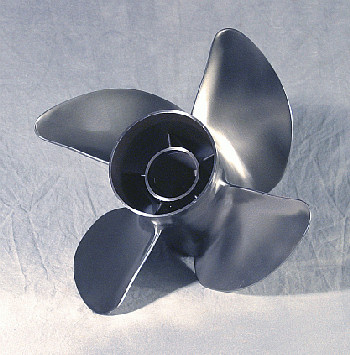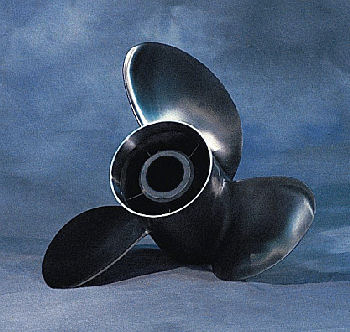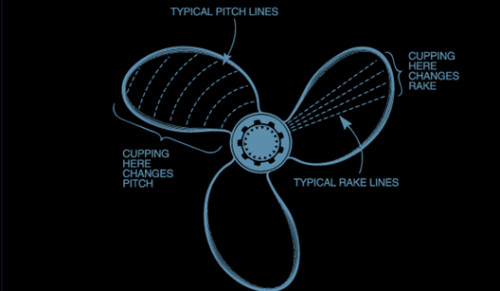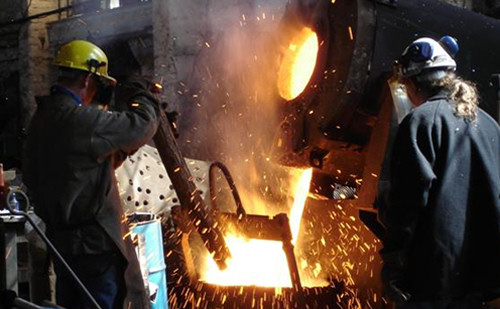4-Blades For Towing Power
Many people running boats with 3-blade props struggle in towing situations. In some cases they have to get Mom and the kids in the bow just to get the boat on plane, sometimes the boat keeps falling off plane when it is slowed down for the skier, and sometimes the boat has to be going so fast to get portly Paul up on his slalom ski he is no longer at the end of the tow rope. All of these scenarios and more are typical of the disadvantages of having a 3-blade prop on a sterndrive lower unit when towing.

Many sterndrive bowriders and sportboats come with 3-blade props no matter what the brand of boat or engine manufacturer. It has been that way since 1957 when the first modern sterndrive was introduced. These props will maximize the boat's speed and they are less costly than a 4-blade prop, but they were not chosen with towing in mind.
Much Better Hole Shots
Simply stated, a 4-blade prop of equal diameter, blade geometry, and blade surface to a 3-blade prop has 33% more total blade area. All other things being equal, more blade area means more thrust. More thrust means more pulling power. That increased thrust and pulling power of a 4-blade prop gives a sportboat a faster and more powerful hole shot. A faster, more powerful hole shot means it is more likely that portly Paul will be able to get up on his slalom ski.

But there are other advantages as well. If you have ever gotten your skier or wakeboarder up, then backed off on the throttle to a more comfortable towing speed (for the person at the end of the tow line), but then found yourself working, or “milking,” the throttle, trying not to fall off plane, then you have experienced another attribute of the 3-blade prop. It simply needs higher rpms and, hence, more speed, than an equivalent 4-blade, to maintain planing power. But more speed is not what the skier wants -- he's telling you to slow down.
When going from a 3-blade to a 4-blade, the pitch is generally lowered one to two inches to account for the additional drag of the fourth blade. This allows the motor to remain in its proper operating range, so it always makes good power, regardless of load, or condition.
The added blade also creates a larger thrust vector, or thrust cone angle, because not only is water being moved aft, it is also being moved out to the sides, to some degree, in a 360-degree circle. Because the propeller is close to the surface of the water, the upward thrust loses its strength as the moving water hits the air and creates a wake, but the downward thrust is of water against water, thereby lifting the stern. Because the stern is being lifted by the 4-blade prop, Momma can get out of the bow. And in some conditions, the boat can stay on plane in slightly lower speeds or fewer rpms.

But Wait, There's More
Because there are more blades there is more "gripping" power when making turns in rough water. Most offshore racing boats run with 4-blade props because they keep the prop engaged with the water more than with a 3-blade prop. This additional grip keeps the wheels from cavitating, which can slow the boat and can make it come off plane. In windy rivers, or on a slalom course, coming off plane or even losing speed may well mean dumping the skier. If you have ever had a blow-out in a sharp turn, you will appreciate a 4-blade prop.
All of these advantages must be offset by some disadvantages. Most 4-blade props won't push the boat as fast as the 3-blade prop it replaces. Depending on the application, this could result in a loss of 1.5 to as much as 4 mph at the top end. Since most people don't care much these days about top speed, it is an unusually agreeable trade. Four-bladed props also cost more than 3-blade units. Add to that the likelihood that you will end up with stainless steel 4-blade props, the up-charge will be from 2.5 times the cost of an aluminum prop to as much as four times the cost. Typically, 4-blade props will cost from $300 to $500 in stainless steel.

Why Stainless Steel?
First, there are not many 4-blade aluminum props on the market. To get the right prop geometry for your specific boat, engine and application requires expensive tooling and since there is little profit margin in aluminum props, prop companies only make a few models. Boaters who know enough to buy a 4-blade prop usually also know that in the long run they will be better off with stainless steel because it can take abuse and can be fixed if necessary. The cost of fixing an aluminum prop is usually so close to the cost of a new one that people just throw them away.
What Specific Geometry?
There is more to a prop than the number of blades and its pitch and diameter. There is also rake, cup, chord, edge shape, hub design and much more. Each of these elements will affect performance. The trick is to make sure the prop you buy meets the needs of your application.